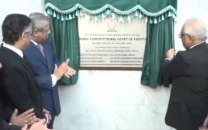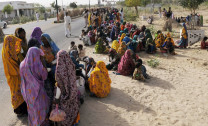Public healthcare on the brink of collapse
Failure of government to decentralize the health network has led to the rush of patients at a few teaching hospitals

Imagine waking up in the middle of the night to a chronically ill loved one complaining of chest pain. The knee-jerk reaction of most would be to rush them to the nearest hospital. However, what can one do when the nearest hospital happens to lie at least two to three hours away.
Owais, a local from Multan found himself in a similar dilemma when a family member of his suddenly had a health scare due to cardiac complications. “Due to the lack of proper healthcare facilities in my city, I had to rush my patient to Lahore, where the load of patients was so high that we had to wait hours for a simple cardiology check-up,” said Owais.
According to Zahid Chaudhry, former senior professor at a private hospital, the current doctor-to-patient ratio in the country’s largest province was alarming. “Approximately 40 per cent of the population is deprived of access to healthcare since the healthcare system operates on routine rather than performance-based principles. The provincial government spends billions annually on healthcare development yet Punjab's healthcare facilities remain inadequate. Furthermore, hospitals in the province are being utilized below their capacity, resulting in the inefficient use of government investments in scanning machines, and operation theatres. Medical institutions were granted complete autonomy in 2003, but this decision remains unimplemented,” revealed Chaudhry.
According to a spokesperson from the Punjab Health Department, field hospitals have been established in areas lacking healthcare facilities, with 20 initially launched and more to follow. "This initiative aims to bring medical treatment to citizens' doorsteps. The government is also providing doctor's facilities in tehsil and district hospitals,” assured the official.
While these efforts must be acknowledged, addressing the cries of Punjab’s ailing healthcare system requires further action and bureaucratic reform since most teaching hospitals suffer from inadequate faculty and staff alongside an ineffective administration while receiving a daily influx of nearly 8,000 patients. For instance, the newly constructed gynaecology tower at Lahore's Sir Ganga Ram Hospital has inadequate staff. Similarly, the General Hospital, which has acquired new machinery for the neurology department, also does not have the required staff available. Same was the case with the intensive care unit established at the Jinnah Hospital back in 2012.
Dr Salman Kazmi, a consultant at the Mayo Hospital, was of the opinion that in order to improve the state of the health sector, doctors must be recruited urgently in those departments where there is a dire shortage. “Since foreign qualified doctors are going back abroad due to low salaries, the salaries of doctors need to be increased. Since a long time the seats in big hospitals like the Mayo Hospital have been vacant but no one has paid any attention to this. Apart from this, the hospitals are not being run to their full capacity since most are functional till only 3pm, after which the out-patient department is closed due to which there is a rush of patients at this time,” explained Dr Kazmi.
As of 2023, Punjab has 399 hospitals with 61,350 beds, 98,811 doctors, and 86,086 nurses, serving a population of over 115 million. This translates to one bed for every 558 patients, one doctor for every 898 patients, and one nurse for every 761 patients.
Former provincial health minister, Dr Javed Akram termed the government's efforts in the healthcare sector mere lip service aimed at gaining political popularity. “The funds allocated for healthcare are being wasted due to poor governance. We need a long-term policy framework to address healthcare challenges,” claimed Dr Akram.



















COMMENTS
Comments are moderated and generally will be posted if they are on-topic and not abusive.
For more information, please see our Comments FAQ